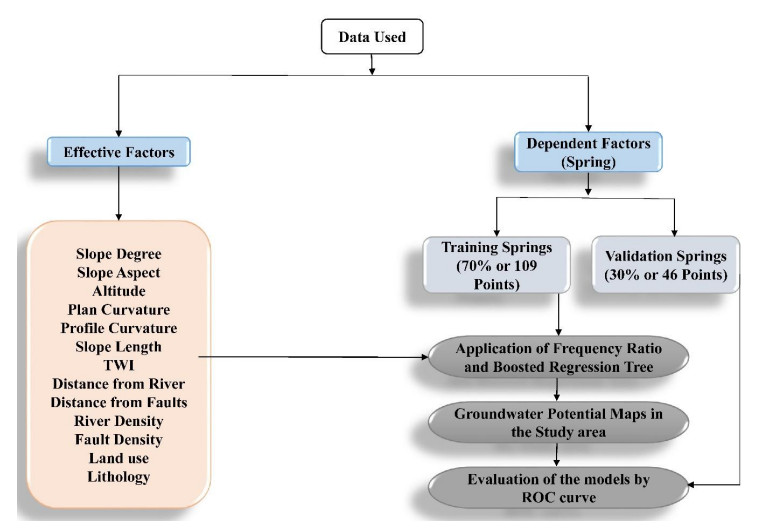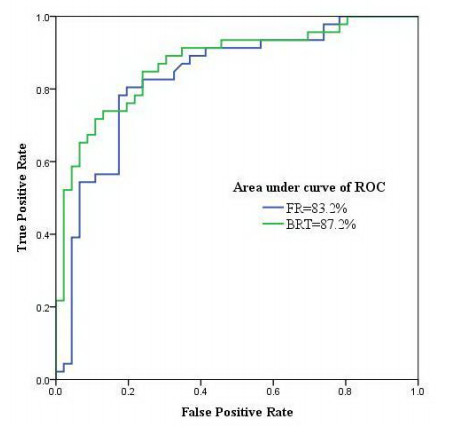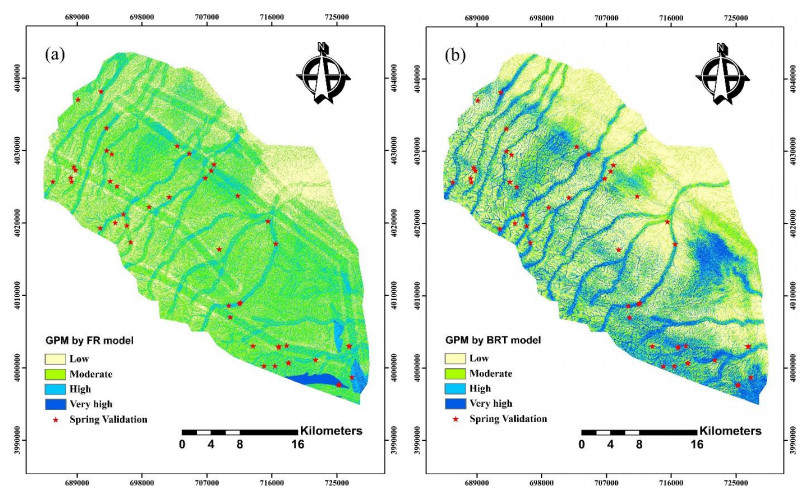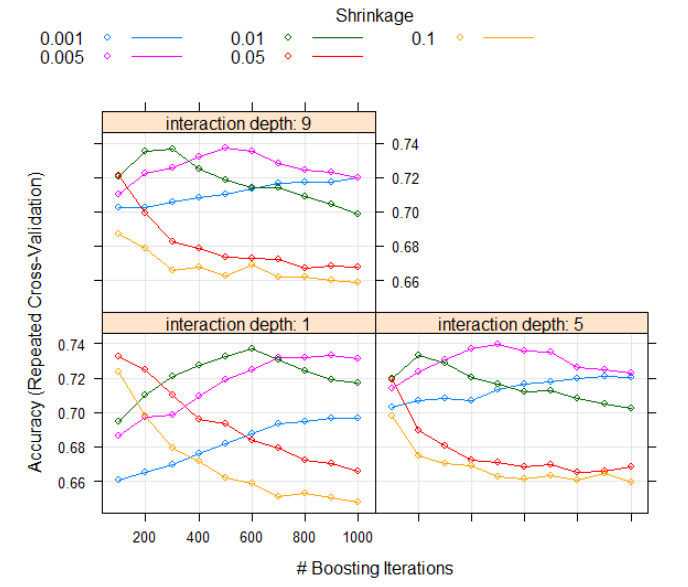| 1.
|
Bahareh Kalantar, Biswajeet Pradhan, Seyed Amir Naghibi, Alireza Motevalli, Shattri Mansor,
Assessment of the effects of training data selection on the landslide susceptibility mapping: a comparison between support vector machine (SVM), logistic regression (LR) and artificial neural networks (ANN),
2018,
9,
1947-5705,
49,
10.1080/19475705.2017.1407368
|
|
| 2.
|
Alireza Arabameri, Wei Chen, Thomas Blaschke, John P. Tiefenbacher, Biswajeet Pradhan, Dieu Tien Bui,
Gully Head-Cut Distribution Modeling Using Machine Learning Methods—A Case Study of N.W. Iran,
2019,
12,
2073-4441,
16,
10.3390/w12010016
|
|
| 3.
|
Jeong-Cheol Kim, Hyung-Sup Jung, Saro Lee,
Spatial Mapping of the Groundwater Potential of the Geum River Basin Using Ensemble Models Based on Remote Sensing Images,
2019,
11,
2072-4292,
2285,
10.3390/rs11192285
|
|
| 4.
|
Phong Tung Nguyen, Duong Hai Ha, Mohammadtaghi Avand, Abolfazl Jaafari, Huu Duy Nguyen, Nadhir Al-Ansari, Tran Van Phong, Rohit Sharma, Raghvendra Kumar, Hiep Van Le, Lanh Si Ho, Indra Prakash, Binh Thai Pham,
Soft Computing Ensemble Models Based on Logistic Regression for Groundwater Potential Mapping,
2020,
10,
2076-3417,
2469,
10.3390/app10072469
|
|
| 5.
|
Sunmin Lee, Yunjung Hyun, Moung-Jin Lee,
Groundwater Potential Mapping Using Data Mining Models of Big Data Analysis in Goyang-si, South Korea,
2019,
11,
2071-1050,
1678,
10.3390/su11061678
|
|
| 6.
|
Jalal Shiri, Mohammad Zounemat‐Kermani, Ozgur Kisi, Sahar Mohsenzadeh Karimi,
Comprehensive assessment of 12 soft computing approaches for modelling reference evapotranspiration in humid locations,
2020,
27,
1350-4827,
10.1002/met.1841
|
|
| 7.
|
Ali Imanian, Vahideh Sheykhi, Kamran Zare, Mohammad Zare,
Introducing the recharge–discharge relationship to evaluate the recharge coefficient of karstic aquifers: thematic and indexing approaches,
2020,
65,
0262-6667,
1385,
10.1080/02626667.2020.1739288
|
|
| 8.
|
Mohsen Zabihi, Hamid Reza Pourghasemi, Alireza Motevalli, Mohamad Ali Zakeri,
2019,
Chapter 1,
978-3-319-73382-1,
1,
10.1007/978-3-319-73383-8_1
|
|
| 9.
|
Alireza Motevalli, Seyed Amir Naghibi, Hossein Hashemi, Ronny Berndtsson, Biswajeet Pradhan, Vahid Gholami,
Inverse method using boosted regression tree and k-nearest neighbor to quantify effects of point and non-point source nitrate pollution in groundwater,
2019,
228,
09596526,
1248,
10.1016/j.jclepro.2019.04.293
|
|
| 10.
|
Soumya S. Singha, Srinivas Pasupuleti, Sudhakar Singha, Rambabu Singh, A. S. Venkatesh,
Analytic network process based approach for delineation of groundwater potential zones in Korba district, Central India using remote sensing and GIS,
2019,
1010-6049,
1,
10.1080/10106049.2019.1648566
|
|
| 11.
|
Davoud Davoudi Moghaddam, Omid Rahmati, Mahdi Panahi, John Tiefenbacher, Hamid Darabi, Ali Haghizadeh, Ali Torabi Haghighi, Omid Asadi Nalivan, Dieu Tien Bui,
The effect of sample size on different machine learning models for groundwater potential mapping in mountain bedrock aquifers,
2020,
187,
03418162,
104421,
10.1016/j.catena.2019.104421
|
|
| 12.
|
Saro Lee, Chang-Wook Lee, Jeong-Cheon Kim,
2019,
Chapter 69,
978-3-030-01439-1,
305,
10.1007/978-3-030-01440-7_69
|
|
| 13.
|
Bahareh Kalantar, Naonori Ueda, Husam Abdulrasool Hammadeh Al-Najjar, Alfian Abdul Halin, Parisa Ahmadi, Mohamed Barakat A. Gibril , Karsten Schulz, Konstantinos G. Nikolakopoulos, Ulrich Michel,
2019,
On the effects of different groundwater inventory scenarios for spring potential mapping in Haraz, northern Iran,
9781510630154,
38,
10.1117/12.2532685
|
|
| 14.
|
Seyed Amir Naghibi, Hossein Hashemi, Ronny Berndtsson, Saro Lee,
Application of extreme gradient boosting and parallel random forest algorithms for assessing groundwater spring potential using DEM-derived factors,
2020,
589,
00221694,
125197,
10.1016/j.jhydrol.2020.125197
|
|
| 15.
|
Seyed Vahid Razavi-Termeh, Abolghasem Sadeghi-Niaraki, Soo-Mi Choi,
Gully erosion susceptibility mapping using artificial intelligence and statistical models,
2020,
11,
1947-5705,
821,
10.1080/19475705.2020.1753824
|
|
| 16.
|
A’kif Al-Fugara, Hamid Reza Pourghasemi, Abdel Rahman Al-Shabeeb, Maan Habib, Rida Al-Adamat, Hani Al-Amoush, Adrian L. Collins,
A comparison of machine learning models for the mapping of groundwater spring potential,
2020,
79,
1866-6280,
10.1007/s12665-020-08944-1
|
|
| 17.
|
Alaa M. Al-Abadi, Jassim J. Alsamaani,
Spatial analysis of groundwater flowing artesian condition using machine learning techniques,
2020,
11,
2352801X,
100418,
10.1016/j.gsd.2020.100418
|
|
| 18.
|
Ehsan Kamali Maskooni, Seyed Amir Naghibi, Hossein Hashemi, Ronny Berndtsson,
Application of Advanced Machine Learning Algorithms to Assess Groundwater Potential Using Remote Sensing-Derived Data,
2020,
12,
2072-4292,
2742,
10.3390/rs12172742
|
|
| 19.
|
Ionut Cristi Nicu, Andrei Asăndulesei,
GIS-based evaluation of diagnostic areas in landslide susceptibility analysis of Bahluieț River Basin (Moldavian Plateau, NE Romania). Are Neolithic sites in danger?,
2018,
314,
0169555X,
27,
10.1016/j.geomorph.2018.04.010
|
|
| 20.
|
Seyed Amir Naghibi, Mojtaba Dolatkordestani, Ashkan Rezaei, Payam Amouzegari, Mostafa Taheri Heravi, Bahareh Kalantar, Biswajeet Pradhan,
Application of rotation forest with decision trees as base classifier and a novel ensemble model in spatial modeling of groundwater potential,
2019,
191,
0167-6369,
10.1007/s10661-019-7362-y
|
|
| 21.
|
Seyed Naghibi, Mehdi Vafakhah, Hossein Hashemi, Biswajeet Pradhan, Seyed Alavi,
Groundwater Augmentation through the Site Selection of Floodwater Spreading Using a Data Mining Approach (Case study: Mashhad Plain, Iran),
2018,
10,
2073-4441,
1405,
10.3390/w10101405
|
|
| 22.
|
Ali Golkarian, Seyed Amir Naghibi, Bahareh Kalantar, Biswajeet Pradhan,
Groundwater potential mapping using C5.0, random forest, and multivariate adaptive regression spline models in GIS,
2018,
190,
0167-6369,
10.1007/s10661-018-6507-8
|
|
| 23.
|
Jeong-Cheol Kim, Hyung-Sup Jung, Saro Lee,
Groundwater productivity potential mapping using frequency ratio and evidential belief function and artificial neural network models: focus on topographic factors,
2018,
20,
1464-7141,
1436,
10.2166/hydro.2018.120
|
|
| 24.
|
Sajjad Mirzaei, Mehdi Vafakhah, Biswajeet Pradhan, Seyed Jalil Alavi,
Flood susceptibility assessment using extreme gradient boosting (EGB), Iran,
2021,
14,
1865-0473,
51,
10.1007/s12145-020-00530-0
|
|
| 25.
|
Optimized Conditioning Factors Using Machine Learning Techniques for Groundwater Potential Mapping,
2019,
11,
2073-4441,
1909,
10.3390/w11091909
|
|
| 26.
|
Mojtaba Dolat Kordestani, Seyed Amir Naghibi, Hossein Hashemi, Kourosh Ahmadi, Bahareh Kalantar, Biswajeet Pradhan,
Groundwater potential mapping using a novel data-mining ensemble model,
2019,
27,
1431-2174,
211,
10.1007/s10040-018-1848-5
|
|
| 27.
|
Abdelmadjid Boufekane, Hind Meddi, Mohamed Meddi,
Delineation of groundwater recharge zones in the Mitidja plain, north Algeria, using multi-criteria analysis,
2020,
22,
1464-7141,
1468,
10.2166/hydro.2020.082
|
|
| 28.
|
Swades Pal, Sonali Kundu, Susanta Mahato,
Groundwater potential zones for sustainable management plans in a river basin of India and Bangladesh,
2020,
257,
09596526,
120311,
10.1016/j.jclepro.2020.120311
|
|
| 29.
|
Bhumika Thapa, Ramesh Raj Pant, Sudeep Thakuri, Gregory Pond,
Assessment of spring water quality in Jhimruk River Watershed, Lesser Himalaya, Nepal,
2020,
79,
1866-6280,
10.1007/s12665-020-09252-4
|
|
| 30.
|
Javed Mallick, Swapan Talukdar, Majed Alsubih, Mohd. Ahmed, Abu Reza Md Towfiqul Islam, Nguyen Viet Thanh,
Proposing receiver operating characteristic-based sensitivity analysis with introducing swarm optimized ensemble learning algorithms for groundwater potentiality modelling in Asir region, Saudi Arabia,
2021,
1010-6049,
1,
10.1080/10106049.2021.1878291
|
|
| 31.
|
Seyed Amir Naghibi, Mehdi Vafakhah, Hossein Hashemi, Biswajeet Pradhan, Seyed Jalil Alavi,
Water Resources Management Through Flood Spreading Project Suitability Mapping Using Frequency Ratio, k-nearest Neighbours, and Random Forest Algorithms,
2020,
29,
1520-7439,
1915,
10.1007/s11053-019-09530-4
|
|
| 32.
|
Ishaku Bashir, Rachel Sallau, Abubakar Sheikh, Zuni Aminu, Shu’aib Hassan,
GIS-based MCDA for Gully Vulnerability Mapping Using AHP Techniques,
2020,
4,
2582-1083,
45,
10.21523/gcj5.20040201
|
|
| 33.
|
Alireza Arabameri, Saro Lee, John P. Tiefenbacher, Phuong Thao Thi Ngo,
Novel Ensemble of MCDM-Artificial Intelligence Techniques for Groundwater-Potential Mapping in Arid and Semi-Arid Regions (Iran),
2020,
12,
2072-4292,
490,
10.3390/rs12030490
|
|
| 34.
|
A'kif Al-Fugara, Mohammad Ahmadlou, Rania Shatnawi, Saad AlAyyash, Rida Al-Adamat, Abdel Al-Rahman Al-Shabeeb, Sangeeta Soni,
Novel hybrid models combining meta-heuristic algorithms with support vector regression (SVR) for groundwater potential mapping,
2020,
1010-6049,
1,
10.1080/10106049.2020.1831622
|
|
| 35.
|
Aliasghar Azma, Esmaeil Narreie, Abouzar Shojaaddini, Nima Kianfar, Ramin Kiyanfar, Seyed Mehdi Seyed Alizadeh, Afshin Davarpanah,
Statistical Modeling for Spatial Groundwater Potential Map Based on GIS Technique,
2021,
13,
2071-1050,
3788,
10.3390/su13073788
|
|
| 36.
|
Yunzhi Chen, Wei Chen, Subodh Chandra Pal, Asish Saha, Indrajit Chowdhuri, Behzad Adeli, Saeid Janizadeh, Adrienn A. Dineva, Xiaojing Wang, Amirhosein Mosavi,
Evaluation Efficiency of Hybrid Deep Learning algorithms with Neural Network, Decision Tree and Boosting Methods for Predicting Groundwater Potential,
2021,
1010-6049,
1,
10.1080/10106049.2021.1920635
|
|
| 37.
|
Nguyen Ngoc Thanh, Pongsathron Thunyawatcharakul, Nguyen Huu Ngu, Srilert Chotpantarat,
Global review of groundwater potential models in the last decade: Parameters, model techniques, and validation,
2022,
614,
00221694,
128501,
10.1016/j.jhydrol.2022.128501
|
|
| 38.
|
Javed Mallick, Swapan Talukdar, Majed Alsubih, Mohammed K. Almesfer, Hoang Thi Hang, Atiqur Rahman,
Integration of statistical models and ensemble machine learning algorithms (MLAs) for developing the novel hybrid groundwater potentiality models: a case study of semi-arid watershed in Saudi Arabia,
2022,
37,
1010-6049,
6442,
10.1080/10106049.2021.1939439
|
|
| 39.
|
Michael Makonyo, Michael M. Msabi,
Identification of groundwater potential recharge zones using GIS-based multi-criteria decision analysis: A case study of semi-arid midlands Manyara fractured aquifer, North-Eastern Tanzania,
2021,
23,
23529385,
100544,
10.1016/j.rsase.2021.100544
|
|
| 40.
|
Biman Ghosh,
Spatial mapping of groundwater potential using data-driven evidential belief function, knowledge-based analytic hierarchy process and an ensemble approach,
2021,
80,
1866-6280,
10.1007/s12665-021-09921-y
|
|
| 41.
|
Chandrashekhar Azad Vishwakarma, Vikas Rena, Deepali Singh, Saumitra Mukherjee,
2021,
9781119709732,
364,
10.1002/9781119709732.ch18
|
|
| 42.
|
Karikkathil C. Arun Kumar, Gangalakunta P. Obi Reddy, Palanisamy Masilamani, Pundoor Sandeep,
Spatial modelling for identification of groundwater potential zones in semi-arid ecosystem of southern India using Sentinel-2 data, GIS and bivariate statistical models,
2021,
14,
1866-7511,
10.1007/s12517-021-07669-0
|
|
| 43.
|
Javed Mallick, Swapan Talukdar, Nabil Ben Kahla, Mohd. Ahmed, Majed Alsubih, Mohammed K. Almesfer, Abu Reza Md. Towfiqul Islam,
A Novel Hybrid Model for Developing Groundwater Potentiality Model Using High Resolution Digital Elevation Model (DEM) Derived Factors,
2021,
13,
2073-4441,
2632,
10.3390/w13192632
|
|
| 44.
|
Hamid Darabi, Omid Rahmati, Seyed Amir Naghibi, Farnoush Mohammadi, Ebrahim Ahmadisharaf, Zahra Kalantari, Ali Torabi Haghighi, Seyed Masoud Soleimanpour, John P. Tiefenbacher, Dieu Tien Bui,
Development of a novel hybrid multi-boosting neural network model for spatial prediction of urban flood,
2022,
37,
1010-6049,
5716,
10.1080/10106049.2021.1920629
|
|
| 45.
|
Raju Das, Sunil Saha,
Spatial mapping of groundwater potentiality applying ensemble of computational intelligence and machine learning approaches,
2022,
18,
2352801X,
100778,
10.1016/j.gsd.2022.100778
|
|
| 46.
|
Massinissa Braham, Abdelmadjid Boufekane, Hamid Bourenane, Baya Nait Amara, Rabah Bensalem, El Hadi Oubaiche, Youcef Bouhadad,
Identification of groundwater potential zones using remote sensing, GIS, machine learning and electrical resistivity tomography techniques in Guelma basin, northeastern Algeria,
2022,
37,
1010-6049,
12042,
10.1080/10106049.2022.2063408
|
|
| 47.
|
Javed Mallick, Swapan Talukdar, Mohd. Ahmed,
Combining high resolution input and stacking ensemble machine learning algorithms for developing robust groundwater potentiality models in Bisha watershed, Saudi Arabia,
2022,
12,
2190-5487,
10.1007/s13201-022-01599-2
|
|
| 48.
|
Mohammadtaghi Avand, Maziar Mohammadi, Fahimeh Mirchooli, Ataollah Kavian, John P. Tiefenbacher,
A New Approach for Smart Soil Erosion Modeling: Integration of Empirical and Machine-Learning Models,
2023,
28,
1420-2026,
145,
10.1007/s10666-022-09858-x
|
|
| 49.
|
Alireza Arabameri, M. Santosh, Hossein Moayedi, John P. Tiefenbacher, Subodh Chandra Pal, Omid Asadi Nalivan, Romulus Costache, Naser Ahmed, Muhammad Al-Amin Hoque, Rabin Chakrabortty, Artemi Cerda,
Application of the novel state-of-the-art soft computing techniques for groundwater potential assessment,
2022,
15,
1866-7511,
10.1007/s12517-021-09005-y
|
|
| 50.
|
Rui Liu, Gulin Li, Liangshuai Wei, Yuan Xu, Xiaojuan Gou, Shubin Luo, Xin Yang,
Spatial prediction of groundwater potentiality using machine learning methods with Grey Wolf and Sparrow Search Algorithms,
2022,
610,
00221694,
127977,
10.1016/j.jhydrol.2022.127977
|
|
| 51.
|
Abinet Addis, Kartik Ariyur,
GIS-Based Landslide Susceptibility Mapping Using Frequency Ratio and Shannon Entropy Models in Dejen District, Northwestern Ethiopia,
2023,
2023,
2314-4912,
1,
10.1155/2023/1062388
|
|
| 52.
|
Sandeepa Pantha, Sachin Timilsina, Sandip Pantha, Shiv Kumar Manjan, Menuka Maharjan,
Water quality index of springs in mid-hill of Nepal,
2022,
9,
26670100,
100658,
10.1016/j.envc.2022.100658
|
|
| 53.
|
Sarmad Dashti Latif, Ali Najah Ahmed,
A review of deep learning and machine learning techniques for hydrological inflow forecasting,
2023,
1387-585X,
10.1007/s10668-023-03131-1
|
|
| 54.
|
Maryam Sadat Jafarzadeh, N Tahmasebipour, Ali Haghizadeh, Hamidreza Pourghasemi, Hamed Rouhani,
The Effect of Observation Data Sampling Methods on Infiltration Areas by Maximum Entropy Model,
2020,
11,
2251-6174,
96,
10.52547/jwmr.11.22.96
|
|
| 55.
|
Prem Ranjan, Pankaj Kumar Pandey, Vanita Pandey,
Groundwater spring potential zonation using AHP and fuzzy-AHP in Eastern Himalayan region: Papum Pare district, Arunachal Pradesh, India,
2023,
1614-7499,
10.1007/s11356-023-26769-w
|
|
| 56.
|
Sandeepa Pantha, Sachin Timilsina, Shiv Kumar Manjan, Menuka Maharjan, Sandip Pantha,
Seasonal Variation of Water Quality Index of Spring in Mid-Hill of Nepal,
2022,
1556-5068,
10.2139/ssrn.4188462
|
|
| 57.
|
Ankit Tyagi, Reet Kamal Tiwari, Naveen James,
Identification of the significant parameters in spatial prediction of landslide hazard,
2023,
82,
1435-9529,
10.1007/s10064-023-03334-w
|
|
| 58.
|
José Miguel Deformes, Jorge Núñez, Jerry P. Fairley, José Luis Arumí, Ricardo Oyarzún,
Assessing Groundwater Potential in a Mid-Mountain Dryland Area of North-Central Chile through Geospatial Mapping,
2023,
15,
2073-4441,
3005,
10.3390/w15163005
|
|
| 59.
|
Hanaa A. Megahed, Amira M. Abdo, Mohamed A. E. AbdelRahman, Antonio Scopa, Mohammed N. Hegazy,
Frequency Ratio Model as Tools for Flood Susceptibility Mapping in Urbanized Areas: A Case Study from Egypt,
2023,
13,
2076-3417,
9445,
10.3390/app13169445
|
|
| 60.
|
V Gholami, M R Khaleghi, M Teimouri, H Sahour,
Prediction of annual groundwater depletion: An investigation of natural and anthropogenic influences,
2023,
132,
0973-774X,
10.1007/s12040-023-02184-0
|
|
| 61.
|
Hanxiang Xiong, Xu Guo, Yuzhou Wang, Ruihan Xiong, Xiaofan Gui, Xiaojing Hu, Yonggang Li, Yang Qiu, Jiayao Tan, Chuanming Ma,
Spatial prediction of groundwater potential by various novel boosting-based ensemble learning models in mountainous areas,
2023,
38,
1010-6049,
10.1080/10106049.2023.2274870
|
|
| 62.
|
Yuwen Chen, AL MAHFOODH,
GIS-statically-based modelling the groundwater quality assessment coupled with soil and terrain attributes data,
2023,
18,
1932-6203,
e0292680,
10.1371/journal.pone.0292680
|
|
| 63.
|
Dara Faeq Hamamin, Arsalan Ahmed Othman, Diary Ali Mohammed Amin Al-Manmi,
Comparison of different statistical approaches to assess spring potential mapping in a multi-aquifer system: a case study of Kurdistan Region, Iraq,
2023,
82,
1866-6280,
10.1007/s12665-023-11250-1
|
|
| 64.
|
Abinet Addis, Gang Mei,
Landslide Susceptibility Mapping Using GIS and Bivariate Statistical Models in Chemoga Watershed, Ethiopia,
2024,
2024,
1687-8094,
1,
10.1155/2024/6616269
|
|
| 65.
|
Lhoussaine El Mezouary, Abdessamad Hadri, Mohamed Hakim Kharrou, Younes Fakır, Abderrahman Elfarchouni, Lhoussaine Bouchaou, Abdelghani Chehbouni,
Contribution to advancing aquifer geometric mapping using machine learning and deep learning techniques: a case study of the AL Haouz-Mejjate aquifer, Marrakech, Morocco,
2024,
14,
2190-5487,
10.1007/s13201-024-02162-x
|
|
| 66.
|
Amaya Adama, Ndjounguep Juscar, Ntoumbe Mama, Tchinda Tsoptie, Bendaoud Rachida, Kah Elvis,
Delineation of groundwater potential zones using multi-criteria analysis (AHP), frequency ratios (RF), remote sensing and GIS: a case study of the Batcham municipality (west Cameroon),
2024,
4,
2730-647X,
10.1007/s43832-024-00108-7
|
|
| 67.
|
Elham Rafiei-Sardooi, Ali Azareh, Hossein Ghazanfarpour, Eric Josef Ribeiro Parteli, Mohammad Faryabi, Saeed Barkhori,
An integrated modeling framework for groundwater contamination risk assessment in arid, data-scarce environments,
2024,
1895-7455,
10.1007/s11600-024-01470-9
|
|
| 68.
|
Abdul Gaffar Sheik, Arvind Kumar, Anandan Govindan Sharanya, Seshagiri Rao Amabati, Faizal Bux, Sheena Kumari,
Machine learning-based monitoring and design of managed aquifer rechargers for sustainable groundwater management: scope and challenges,
2024,
1614-7499,
10.1007/s11356-024-35529-3
|
|
| 69.
|
Deepak Patle, Manoj Kumar Awasthi, Shailesh Kumar Sharma, Yogesh Kishore Tiwari,
A Geoinformatics-Based Comparative Study of Multi-Criteria Decision Making Approaches of Groundwater Potential Zoning in Ken Basin, India,
2024,
0255-660X,
10.1007/s12524-024-02062-2
|
|
| 70.
|
Sumon Dey, Swarup Das,
Swarm optimization based heterogeneous machine learning techniques for enhanced landslide susceptibility assessment with comprehensive uncertainty quantification,
2025,
18,
1865-0473,
10.1007/s12145-024-01617-8
|
|
| 71.
|
Devanantham Abijith, Subbarayan Saravanan, K S S Parthasarathy, Nagireddy Masthan Reddy, Janardhanam Niraimathi, Ahmed Ali Bindajam, Javed Mallick, Maged Muteb Alharbi, Hazem Ghassan Abdo,
Assessing the impact of climate and land use change on flood vulnerability: a machine learning approach in coastal region of Tamil Nadu, India,
2025,
12,
2196-4092,
10.1186/s40562-025-00377-7
|
|
| 72.
|
Kazi Ashrafuzzaman, Sujit Kumar Roy, Md. Mahmudul Hasan, Pratik Mojumder, Nahrin Jannat Hossain,
2025,
Chapter 6,
978-3-031-89245-5,
97,
10.1007/978-3-031-89246-2_6
|
|









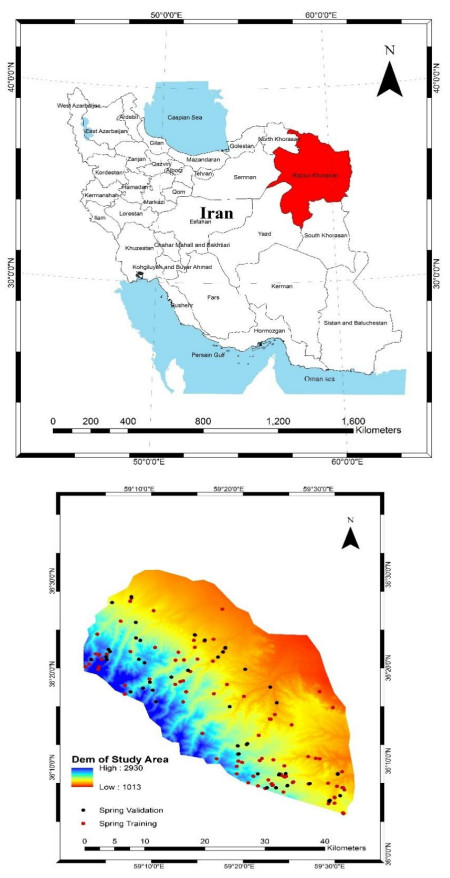
 DownLoad:
DownLoad: 
